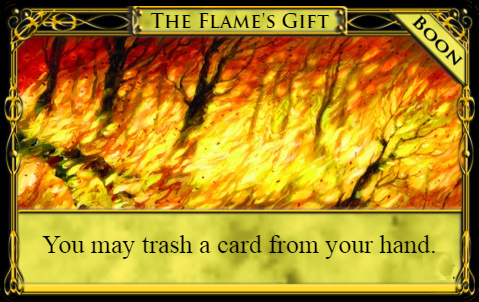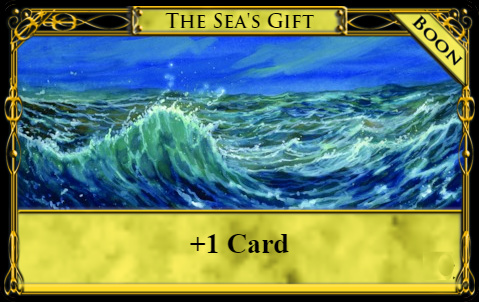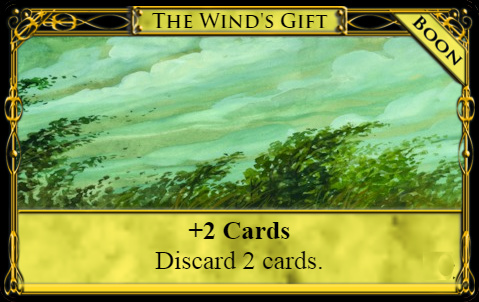Hexes
It has been 16 months since we were first introduced to Hexes in the Nocturne Previews, and it seems we are still far away from understanding the average impact they have on our games. I believe people, even smart people like us, are generally poor at evaluating the effects of rare, random events. Hexes certainly fall into this category. Any particular Hex shows up in a little over 1/3 of the games with Doom cards. That is not much data from which to form an opinion!
Fortunately, markus (with the help of ceviri's Woodcutter tool) has gathered a ton of data from high-level Dominion matches online. He has data from nearly 7500 games with Hexes and has estimated the effect on win probability from receiving one more of a particular hex than your opponent. These data are available
here on the sheet titled 'Gain Advantage'. Similar information can be seen on the stat charts he made
here. What these data seem to tell us about Hexes contrasts pretty sharply with some of the rankings below.
Hexes can be received in a variety of ways: markus estimates 80% of Hexes come from attacks, 15% from Cursed Village gains and the remaining 5% from Leprechaun plays. The circumstances of receiving a Hex can influence how harmful it is. The effect of some Hexes is muted when received in combination with another. For others the effect is nearly invariant to game state.
I will generally discuss these Hexes from the perspective of the Receiving player.
 | | | | #1 =0 Delusion Weighted Average: 94.2% ▲9.6pp / Unweighted Average: 93.0% / Median: 100.0% =0.0pp / Standard Deviation: 14.8%
There is nothing else like this Attack in the game. While its strength depends on the card-pool (presence of Events, Projects, Night, alt-treasure cards diminish its impact), action-card denial in the early or middle stages of a game can seemingly put a player a full turn behind their opponent. It received 9/13 first place votes. Interestingly, this falls just middle-of-the-pack in markus’ stats. Is it possible that we remember those times Delusion kills us early but forget when it does next-to-nothing late? |
 | | | | #2 ▲4 Poverty Weighted Average: 74.5% ▲7.8pp / Unweighted Average: 75.5% / Median: 81.8% ▲9.1pp / Standard Deviation: 19.3%
This year’s biggest riser in the rankings, Poverty was voted first twice. Given that this is just a bog-standard Militia attack, I was a little surprised to see it this high. This can hurt with Leprechaun but is generally a Hex you hope to see when buying Cursed Village. The stats rate this as the 10th most effective Hex. Two Hexes in, and two major disagreements between the stats and the rankings. |
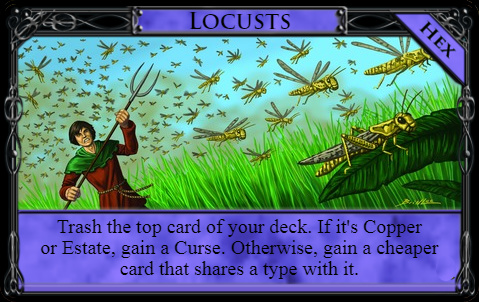 | | | | #3 ▼1 Locusts Weighted Average: 71.9% ▼7.0pp / Unweighted Average: 72.7% / Median: 72.7% ▼9.1pp / Standard Deviation: 15.1%
There are plenty of Locusts horror stories: gaining a Cursed Village on an empty deck, an opponent hitting your Champion, or a Vampire getting turned into a Pirate Ship. Generally, the outcome isn’t that bad. What many might suggest as the most common nightmare case – getting a Province trashed – is typically a 3-VP deduction, an outcome on par with Misery. While some of the Hexes diminish when combined with other Hexes, Locusts hits no matter when or how you receive it, and arguably gets stronger with Haunting, Bad Omens and Greed. This ranked 5th in the stats. |
 | | | | #4 ▼1 War Weighted Average: 68.4% ▼1.2pp / Unweighted Average: 70.6% / Median: 72.7% ▲9.1pp / Standard Deviation: 16.4%
Similar to Locusts, War always “works”. It may find nothing, or it may find something you can convince yourself you didn’t want anyway, but it’s generally doing something harmful every time it is received. Not every Hex can say that. The stats also place War 4th. |
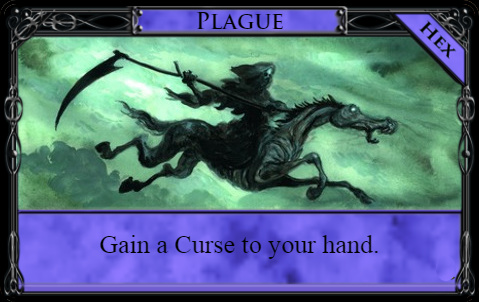 | | | | #5 ▼1 Plague Weighted Average: 67.2% ▲0.7pp / Unweighted Average: 63.6% / Median: 54.5% ▼9.1pp / Standard Deviation: 16.7%
As Cursers go, this one is pretty mild, but even weak junking is harmful. As with War and Locusts, there is no minimizing the impact of this Hex while Curses remain in the supply. You could argue that this one hurts more to receive with Cursed Village than from an opponent’s attack. This Hex ranks 3rd in the stats. |
 | | | | #6 ▼1 Envy Weighted Average: 57.6% ▼8.6pp / Unweighted Average: 62.2% / Median: 72.7% ▼9.1pp / Standard Deviation: 25.2%
Like Delusion, Envy’s attack is unique. The average effect may not be very harmful, but it can completely derail end-game turns that rely on treasure payload. I had a game once where my opponent twice got Envy on what would have otherwise been double Province turns. Seems pretty bad, right? Let’s revisit the language I just used: “I had a game once…” This anecdotal experience has stuck with me, and as a result, I probably overrate Envy. So, what does the data tell us? It’s quite harsh: Envy ranks as the most impotent Hex. |
 | | | | #7 ▲2 Misery Weighted Average: 44.2% ▲8.6pp / Unweighted Average: 44.1% / Median: 36.4% =0.0pp / Standard Deviation: 23.3%
Getting two “anti-VP tokens” often feels inconsequential. After all, the card does absolutely nothing to directly affect your deck or your ability to build. But this Hex does something irreparably bad to your score each of the first two times it hits. Simply put, there is no escaping the damage it does, and it has a very real, measurable effect on the outcome of the game. This is the top-ranked Hex in the stats by a comfortable margin. |
 | | | | #8 =0 Greed Weighted Average: 41.7% ▲4.2pp / Unweighted Average: 40.6% / Median: 45.5% ▲9.1pp / Standard Deviation: 18.1%
Greed follows Plague’s theme of weak junking by handing out a slightly more palatable type of junk but putting it where you least want it: the top of your deck. How bad could that be? Well, the stats think it’s pretty bad: it ranks second only to Misery. Notably this puts it just above Plague. |
 | | | | #9 ▼2 Haunting Weighted Average: 30.7% ▼12.1pp / Unweighted Average: 32.2% / Median: 27.3% ▼9.1pp / Standard Deviation: 15.8%
This mini Ghost Ship attack feel less than half as harmful as a regular Ghost Ship, but that seems to be consistent with the power level of Hexes. It interacts with many of the other Hexes, so consider carefully what you top deck when you’re getting hit with multiple Hexes on a turn |
 | | | | #10 =0 Bad Omens Weighted Average: 24.3% ▼2.5pp / Unweighted Average: 20.3% / Median: 9.1% ▼9.1pp / Standard Deviation: 21.7%
This Hex is only occasionally harmful and can actually be very helpful in certain situations (such as triggering a shuffle between turns 1 and 2). The better your deck is, the less this one hurts, and even if you do get two Coppers on top, knowing that they’re there can be useful. Here we see general agreement between the voters and the stats, where it finished 11th. Two people voted it last. |
 | | | | #11 =0 Fear Weighted Average: 23.6% ▲0.8pp / Unweighted Average: 23.8% / Median: 27.3% ▲9.1pp / Standard Deviation: 7.6%
It’s easy to underrate this Hex or dismiss it as merely a Cutpurse. The difference is that this it scales with your deck. Getting hit with this late is comparable to a Raider attack, which isn’t nothing. It can fail to hit when combined with other discard Hexes (such as Poverty or Haunting). |
 | | | | #12 =0 Famine Weighted Average: 1.6% ▼1.5pp / Unweighted Average: 1.4% / Median: 0.0% =0.0pp / Standard Deviation: 3.3%
If there’s a Hex on this list that makes me question the stats, it’s this one. Almost unanimously picked as the weakest Hex (11/13 picked it last, the other two picked it 2nd-to-last), the effect of this Hex according to the data is on par with Delusion and Fear, but a step below Locusts. Perhaps this is another case of a Hex hitting every time, and therefore having a larger average effect than we tend to notice. |


















